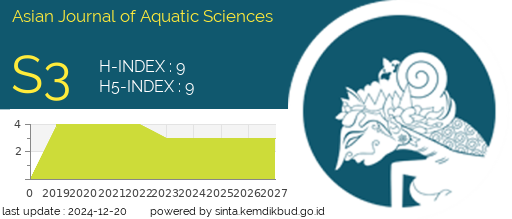ABUNDANCE AND DIVERSITY OF PHYTOPLANKTON IN THE WATERS OF TELUK LECAH VILLAGE, RUPAT, BENGKALIS
DOI:
https://doi.org/10.31258/ajoas.7.3.329-335Keywords:
Diversity, Phytoplankton, Teluk Lecah VillageAbstract
The aim of carrying out the research is to determine the abundance and diversity of phytoplankton. The method used in this research is a survey method, namely data collection, documentation, and direct observation in the field. Samples were analyzed at the Marine Biology Laboratory of Riau University. The results of the research show that there are six types of phytoplankton found in the waters of Teluk Lecah Village, Rupat District, Bengkalis Regency, namely Synedra sp, Dactylococcopsis sp, Nitzschia sp, Tribonema sp, Cylindrotheca sp, and Rhizosolenia sp. The first highest phytoplankton abundance was at station II, with an abundance of 0.1660, followed by the second highest phytoplankton abundance at station I, namely the residential area, with an abundance of 0.1494 Ind/L, while the lowest phytoplankton abundance was at station III, namely at the harbor with an abundance of 0. ,0996 Ind/L. The species diversity index at stations I and III, H' > 3, means the level of species diversity is high and the water conditions are not polluted. At station II, 1 ≤ H' ≤ 3 means the level of species diversity is moderate, and the water conditions are lightly polluted. It can be concluded that the H' value still meets the criteria. The species diversity index at all stations, E > 0.5, means that the uniformity of organisms is in balance, and there is no competition for certain places or food. It can be concluded that the E value also meets the criteria. Species dominance index at all stations, D < 0.5 means no dominant species exists
Downloads
References
1. Arisyana, A., Yuliana, Y. Produktivitas Perairan. Bumi Aksara. Jakarta, 2012
2. Leonardo, E.A. Kelimpahan dan Keanekaragaman Fitoplankton di Perairan Pesisir Holtekamp Kota Jayapura. Jurnal Biosilampari: Jurnal Biologi, 2019; 2(1): 6-15.
3. Davis, G.C. The Marine and Freshwater Plankton. Michigan State University Press. The USA. 526p, 1995
4. Yamaji, I. Illustration of Marine Plankton of Japan. Hoikiska Publ. Co. Ltd. Japan. 572p, 1976
5. [APHA] American Public Health Association. Standard Methods for the Examination of Water and Wastewater. American Public Control Federation. 19th Edition, Washington DC. American Public Health Association Inc, 1989
6. Odum, E.P. Fundamental of Ecology. Third edition. W.B. Saunders Co. Philadelphia and London. 546 p, 1971
7. Heryanto, A. Pengaruh Faktor Lingkungan terhadap Stuktur Komunitas Plankton pada Ekosistem Mangrove Muara Angke. Balai Penelitian dan Observasi Laut, 2020; 1: 79-91.
8. [BPS] Badan Pusat Statistik Kabupaten Bengkalis. Bengkalis dalam Angka. BPS Kabupaten Bengkalis.
9. Hamuna, B., Tanjung, H.R., Suwito, W., Maury, H., & Alianto, A. Kelimpahan dan Tingkat Kesuburan Plankton Sungai Bedog. Jurnal Pendidikan Biologi dan Sains, 2019; 5(6): 1-9.
10. Kamilah, K. Keanekaragaman Plankton yang Toleran terhadap Kondisi Perairan Tercemar di Sumber Air Belerang, Sumber Beceng Sumenep, Madura. Jurnal Lenterabio, 2020; 3(3): 226-231.
11. Aisoi, L.E. Kelimpahan dan Keanekaragaman Fitoplankton di Perairan Pesisir Holtekamp Kota Jayapura. Jurnal Biosilampari: Jurnal Biologi, 2019; 2(1): 6 – 15.
12. Carong, S. Struktur Komunitas Ikan di Perairan Pantai Kabupaten Mimika Provinsi Papua Indonesia. Jurusan Biologi. Universitas Hasanuddin. Makassar, 2019








